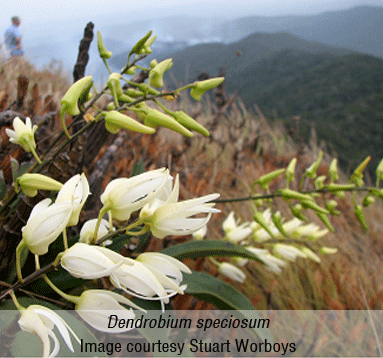<< BACK TO PROJECT LIST
Project: 280/2011
Title: Resolving species concepts in the contentious Dendrobium speciosum complex using molecular data.
Applicant: Lalita Simpson
Institution: Australian Tropical Herbarium & the School of Marine and Tropical Biology, James Cook University, Cairns
Supervisors: Dr. Katharina Schulte (ATH, Cairns), Dr. Mark Clements (CANB, Canberra), Prof. Darren Crayn (ATH, Cairns)
The Dendrobium speciosum complex comprises a group of closely related Australian endemic orchids. One of Australia’s most wide spread orchid groups occurring from north eastern Victoria to Cooktown in far north Queensland, the complex shows considerable morphological variability across its range. Although putative morphological groups are recognised that appear to be associated with geographical regions, the pattern of variability is complex and in many areas morphological intermediates also exist. Several taxonomic treatments have been proposed for the complex however classifications do not agree on the number of distinct groups or the taxonomic rank (species, sub-species or variety) at which these groups should be recognised. Currently any one group may be referred to under various names and taxonomic ranks inconveniencing taxonomists, horticulturalists and enthusiasts alike. Independent evidence such as molecular data of the genome can assist in identifying appropriate taxonomic groups and in clarifying the relationships between them to provide a more stable and widely accepted classification of the complex.
This research will use a DNA fingerprinting method (AFLPs) to provide molecular evidence of the phylogenetic relationships within the D. speciosum complex. The groups revealed through phylogenetic analysis of AFLP data will be reviewed in the context of their biogeography and pollination biology and compared to putative morphological groups proposed in previous taxonomic treatments. This will provide an independent test of those concepts.

Research outcomes:
This study has resolved relationships within the D. speciosum complex based on a large molecular dataset collected from 89 individuals from across the extensive distribution of the complex along Australia’s east coast. Results from DNA fingerprinting have identified two genetically divergent lineages within the D. speciosum complex, a northern and a southern lineage. These are separated by the St Lawrence Gap, a biogeographic barrier of dry sclerophyll forest and woodland that intersects the wetter forest communities that occur along Queensland’s Australia’s east coast. Many individuals sampled were found to have mixed genetic profiles indicating that genetic exchange through the dispersal of pollen, was occurring between the northern and southern lineage. The highest degree of genetic mixture was found in individuals that occur within 100 km of the St Lawrence Gap indicating this is a zone of contact between the two groups.
Today, the St Lawrence gap presents a narrow gap in the distribution of D. speciosum populations; however distribution models of D. specioum under climatic conditions of past glacial periods showed that during these cool dry climatic conditions the St Lawrence Gap was a much broader area of unsuitable habitat separating northern and southern populations. Geographic isolation during these periods has most likely resulted in reproductive isolation facilitating genetic divergence between the northern and southern populations. Subsequent expansion towards a more continuous distribution along the east coast during interglacial periods such as under today’s climate, has allowed recurrent contact between the previously isolated northern and southern lineage.
Previous classifications of the D. speciosum complex based on morphology have recognised between one and eleven species within the complex; however analysis of genetic data did not provide statistical support for any of these taxa as divergent lineages. Thus our results support a taxonomic treatment of the complex as one species, with the northern and southern lineages recognised as subspecies based on evidence of genetic exchange between the two groups. The rank of variety is considered most appropriate for morphologically distinct groups within the northern and southern lineage.
This study has clarified phylogenetic relationships within the D. speciosum complex and revealed the impact of past climatic shifts on the distribution of Australia’s forests species. Funding for the project was provided by the Australian Biological Resources Study (BushBlitz grant BBR210-34) and the Australian Orchid Foundation (280/2011).
Published papers as a result of this project:
Lalita Simpson, Mark A. Clements, Darren M. Crayn, Katharina Nargar (2018), Evolution in Australia’s mesic biome under past and future climates: Insights from a phylogenetic study of the Australian Rock Orchids (Dendrobium speciosum complex, Orchidaceae), In Molecular Phylogenetics and Evolution, Volume 118, Pages 32-46, ISSN 1055-7903, https://doi.org/10.1016/j.ympev.2017.09.004.
http://www.sciencedirect.com/science/article/pii/S1055790317300246
Conference presentations:
- Simpson, L., Clements, M., Crayn, D., Schulte, K. (2012): Mind the Gap: phylogeography and taxonomy of the Dendrobium speciosum complex (Orchidaceae). Australasian Systematic Botany Society conference: Local Knowledge, global delivery, 24. Sep. 2012. Talk
- Simpson, L., Clements, M., Crayn, D., Schulte, K. (2013): Australia’s King Orchid – one species or many? A phylogeographic approach to resolving taxonomic limits within the Dendrobium speciosum complex (Orchidaceae). BioSyst.Eu – Global Systematics! Conference, Vienna, Austria, 22. Feb. 2013.
